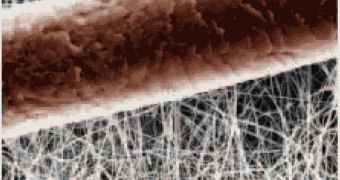A new and improved material can produce sensors used in explosives detection. The fluorescent sensor could find practical applications in new devices built for rapid detection of explosives in security screening, criminal investigations, and other applications.
Southern Illinois University's Ling Zang and colleagues at the University of Illinois at Urbana-Champaign and the Chinese Academy of Sciences presented the new device that overcomes the general problems of detecting explosives by losing their glow.
Today's explosive detectors are typically based on ion mobility spectrometry (IMS). With this technique, explosive compounds pass down a length of tubing where they are ionized by a strong electric field. The distinctive drift speed and "kinetic signature" of each molecule allows the sensor to discriminate between compounds with different mobilities.
The new generation of sensor materials is a fluorescent film made of nanofibrils, which can sense the presence of vapors from TNT and a related explosives compound with greater effectiveness than existing materials.
During the tests, the material was able to recover its ability to fluoresce after initially losing its fluorescence while sensing the explosive compounds. Nanofibrils are carbon nanotubes predominantly having diameters substantially less than about 200 nm.
The foregoing nanotubes or nanofibrils are grown in aggregates having a macroscopic morphology of either bundles of relatively straight tubules, cotton candy ("CC"), or approximately spherical aggregates of highly intertwining, curved tubulesresembling bird nests ("BN"), or combinations of these.
The invention uses essentially amorphous cellulose nanofibrils having a crystallinity index not more than 50 % as emulsifying and/or stabilizing agent in a dispersion. The nanofibrils can be used in the form of an aqueous suspension, or in dispersible dry form.

 14 DAY TRIAL //
14 DAY TRIAL //